THE CAES ADVANTAGE
CAES Advantages vs. Traditional Gas-Fired Power Generation
Lower Heat Rate
CAES power plants have a heat rate advantage over simple cycle or combined cycle power plants, resulting in improved overall fuel efficiency. The heat rate is a measure of the fuel efficiency of a power plant, indicating the amount of fuel (btu) required to generate a unit of electricity (kwh). The lower heat rate of CAES plants means they can generate the same amount of electricity using less fuel, resulting in significantly reduced emissions and lower operating costs per unit of electricity produced. This makes CAES an attractive option for energy storage, as it can contribute to a more sustainable and cost-effective power generation system.
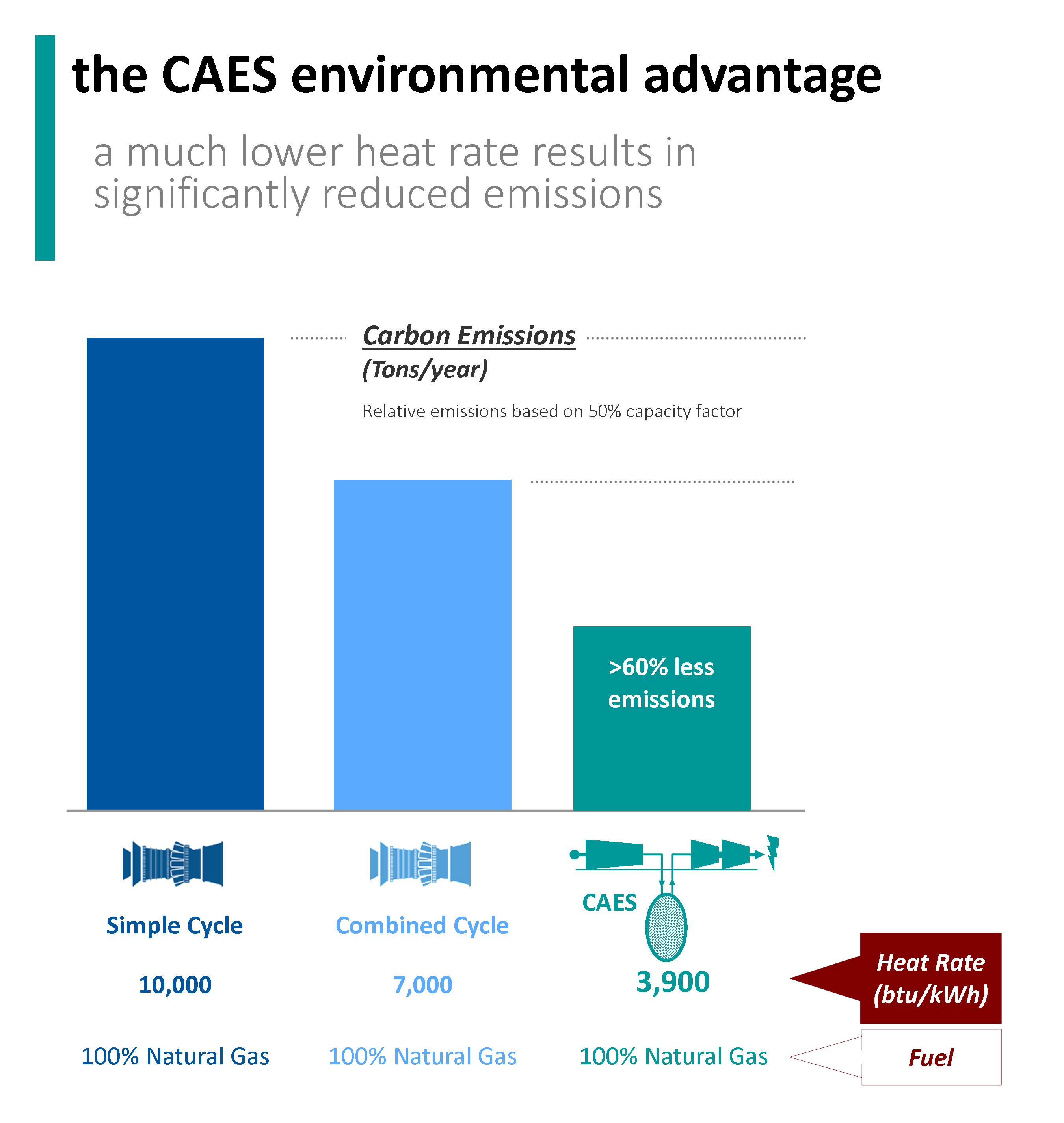
Energy Storage Capability
CAES power plants can act as both power generation and energy storage systems, providing a flexibility and additional value in their operations that conventional generation technologies do not. During periods of low electricity demand or excess renewable energy generation, CAES plants can use the excess electricity to compress air and store it in underground caverns. When electricity demand increases, the stored compressed air can be released, heated using natural gas or hydrogen, and expanded through turbines to generate electricity. This flexibility allows CAES plants to provide grid stability and support the addition and integration of intermittent renewable energy sources, reducing the need for more carbon-intensive backup power plants.
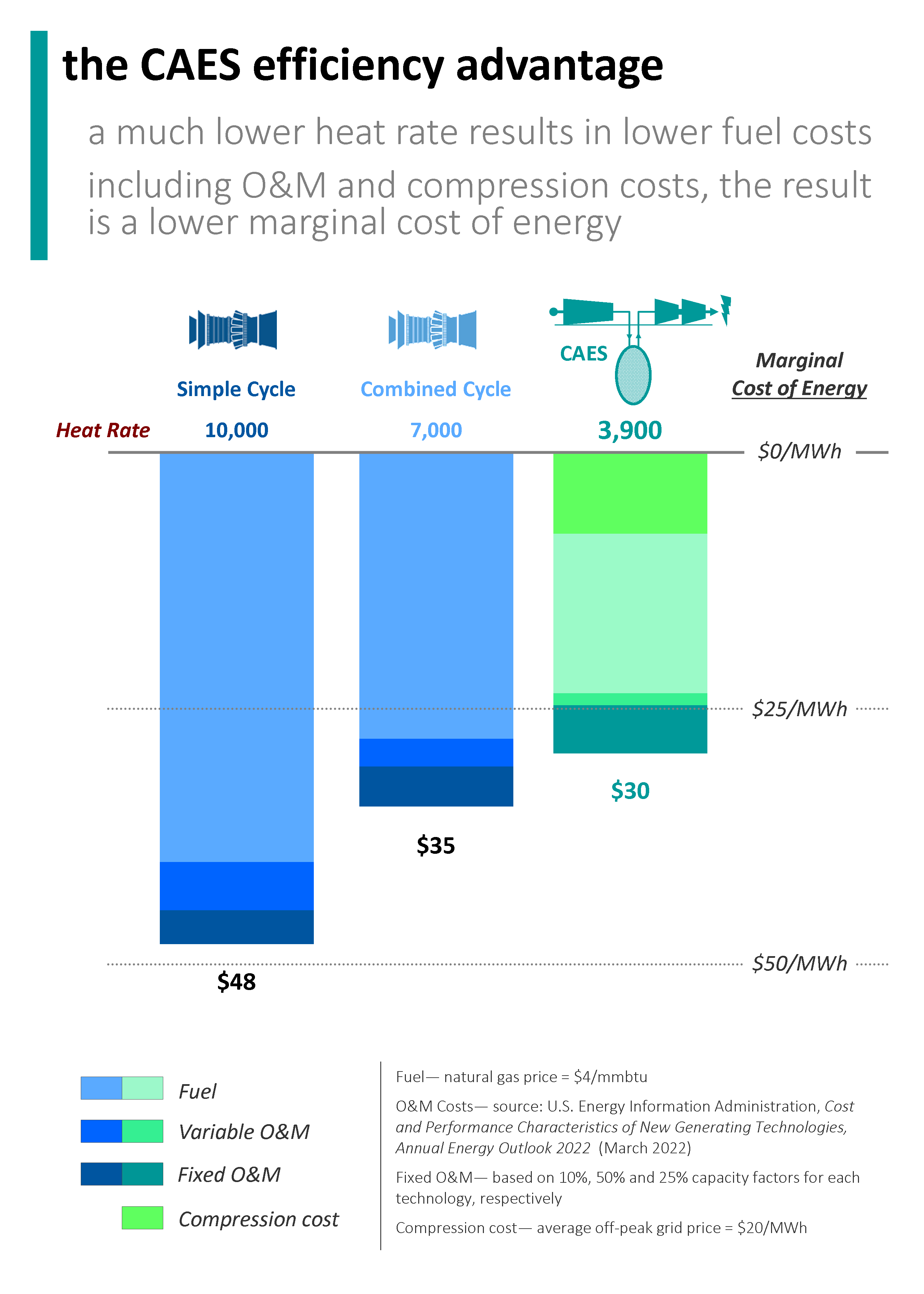
Parallel Operations
CAES power plants are designed to allow for the separate but concurrent operation of both the compression and expansion phases, providing flexibility to compress air into storage or directly into the expansion turbines. This allows CAES to operate and generate electricity even if the caverns have been depleted, providing the ability to capture longer periods of higher market prices that may exceed the storage duration available.
CAES Advantages vs. Batteries
Lower Capital Costs & Longer Life Cycle
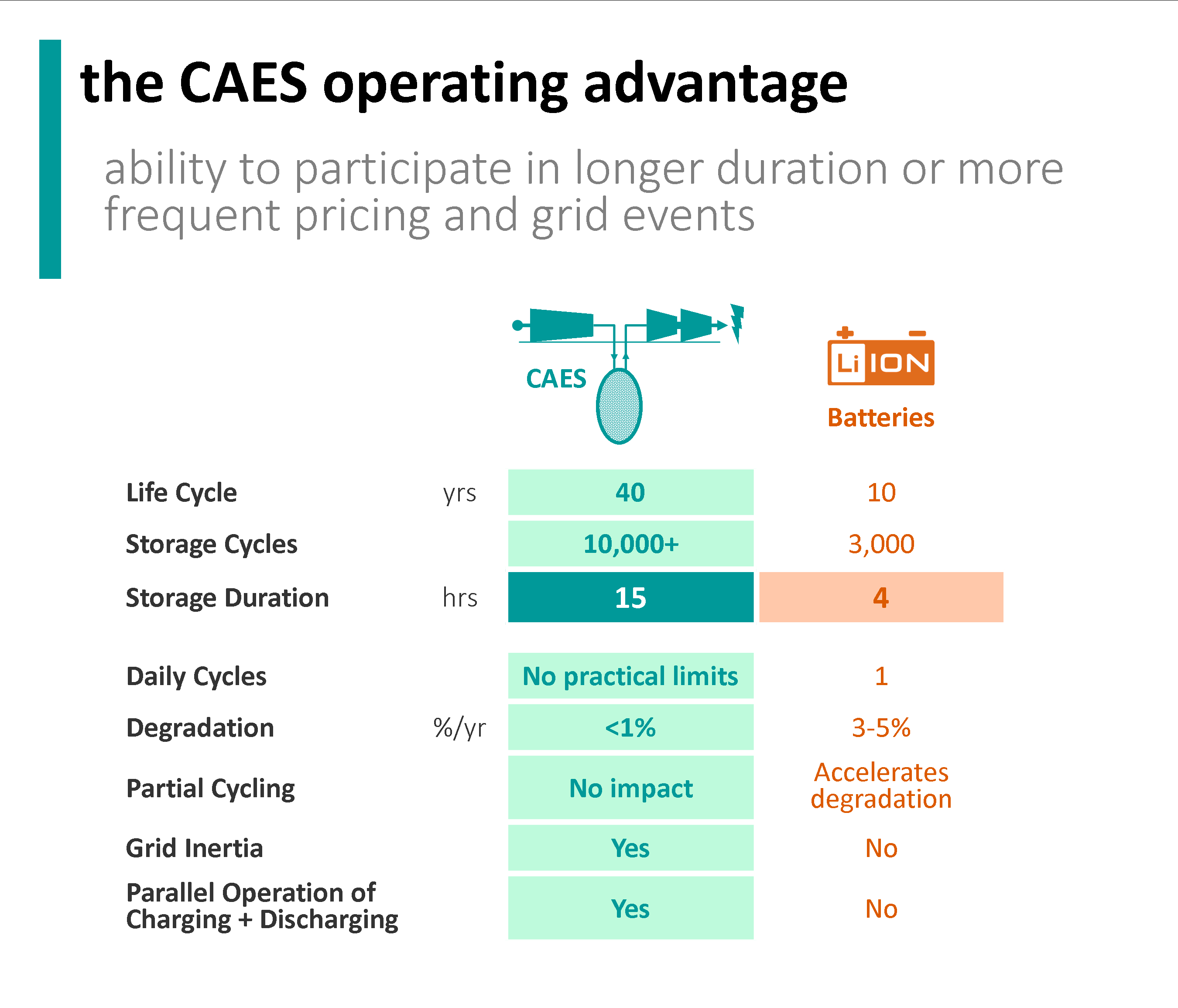
CAES uses simple and well-established technologies such as turbines and compressors, which have longer operational lifespans and can be maintained and refurbished over time. This extended operational life and reduced need for frequent replacements make CAES systems more durable and cost-effective in the long run, providing a higher return on investment for energy storage projects. Batteries have a limited number of charge-discharge cycles before their capacity and performance start to degrade. The degradation of battery systems over time necessitates replacement or refurbishment, which adds to the life cycle costs. In contrast, CAES systems do not experience the same degradation issues associated with batteries.
Longer Storage Duration
Batteries, although highly efficient and rapidly deployable, are generally better suited for short-duration storage. However, the underground caverns used for CAES can store vast amounts of compressed air for extended periods, ranging from several hours to several days. This extended storage duration makes CAES particularly valuable for applications that require prolonged shifting of excess generation or backup power, such as in areas with greater amounts of intermittent renewable energy sources or during extended grid outages. The ability of CAES to store energy for longer durations provides greater grid flexibility and reliability.
Grid Inertia
Grid inertia refers to the ability of the power system to maintain stable operation in response to sudden changes in power supply or demand. CAES, by utilizing turbines and generators, can contribute to the inertia of the grid as it operates similarly to conventional power plants. This feature becomes especially important as the penetration of renewable energy increases since renewables typically have lower inherent inertia. Battery storage, on the other hand, does not inherently contribute to grid inertia. However, battery systems can be paired with other technologies or control strategies to mimic or enhance grid inertia, albeit with additional costs and complexities.
Parallel Operations
CAES can operate in “charge” and “discharge” mode simultaneously. CAES systems can inject excess electricity from the grid to compress air and store it for later use, while also generating electricity during periods of high demand. This simultaneous operation allows for greater grid flexibility and responsiveness. In contrast, batteries have a more limited capability to charge and discharge at the same time. A battery system’s ability to simultaneously charge and discharge is generally constrained. This unique characteristic of CAES makes it well-suited for applications where there is a need for continuous energy storage and power generation, providing a more versatile solution for balancing supply and demand on the grid.
Hydrogen to Fuel the Future
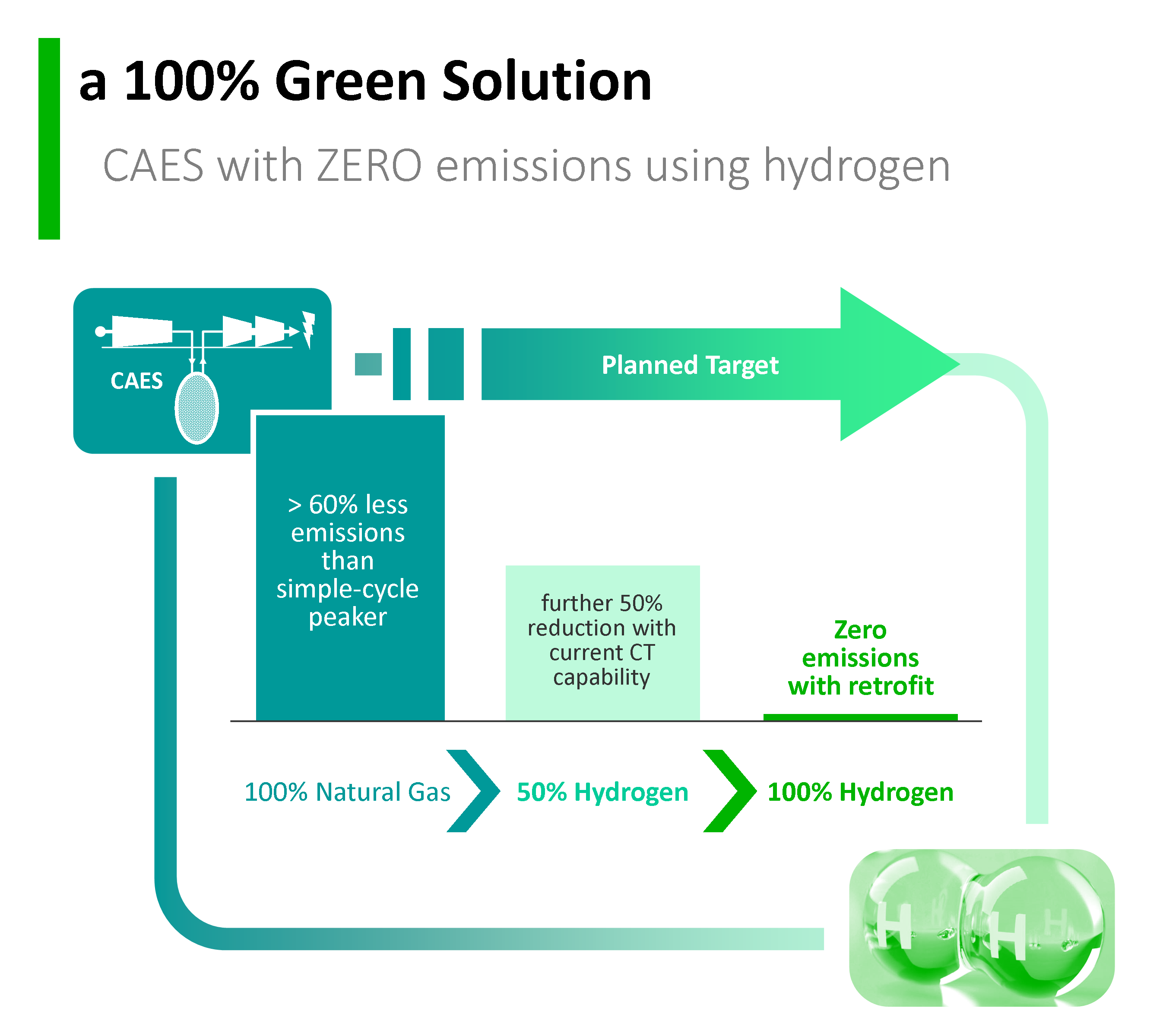
The transition from natural gas to hydrogen as a fuel source for CAES is more attainable due to its lower heat rate and lower operating hours (or capacity factor). With CAES operating at a lower heat rate compared to conventional gas turbines, it will require less fuel to generate the same amount of electricity. The lower heat rate of CAES allows for a more efficient utilization of hydrogen, reducing the amount of hydrogen needed to generate the same power output. This makes it easier to integrate hydrogen into the existing infrastructure and power generation systems.
Furthermore, CAES inherently will operate at a lower capacity factor (ie. less hours of operation). This characteristic is beneficial when transitioning to hydrogen as a fuel source because it allows for a more flexible and gradual adoption of hydrogen. The lower capacity factor of CAES means that less quantities of hydrogen is required to meet the fluctuating demand, enabling a smoother transition without the need for immediate large-scale production and storage capacities for hydrogen.
These characteristics position CAES as a viable technology for facilitating the transition to a hydrogen-based energy system on a more cost-effective basis while maximizing efficiency and minimizing infrastructure challenges.
Multiple Caverns Provide Optionality
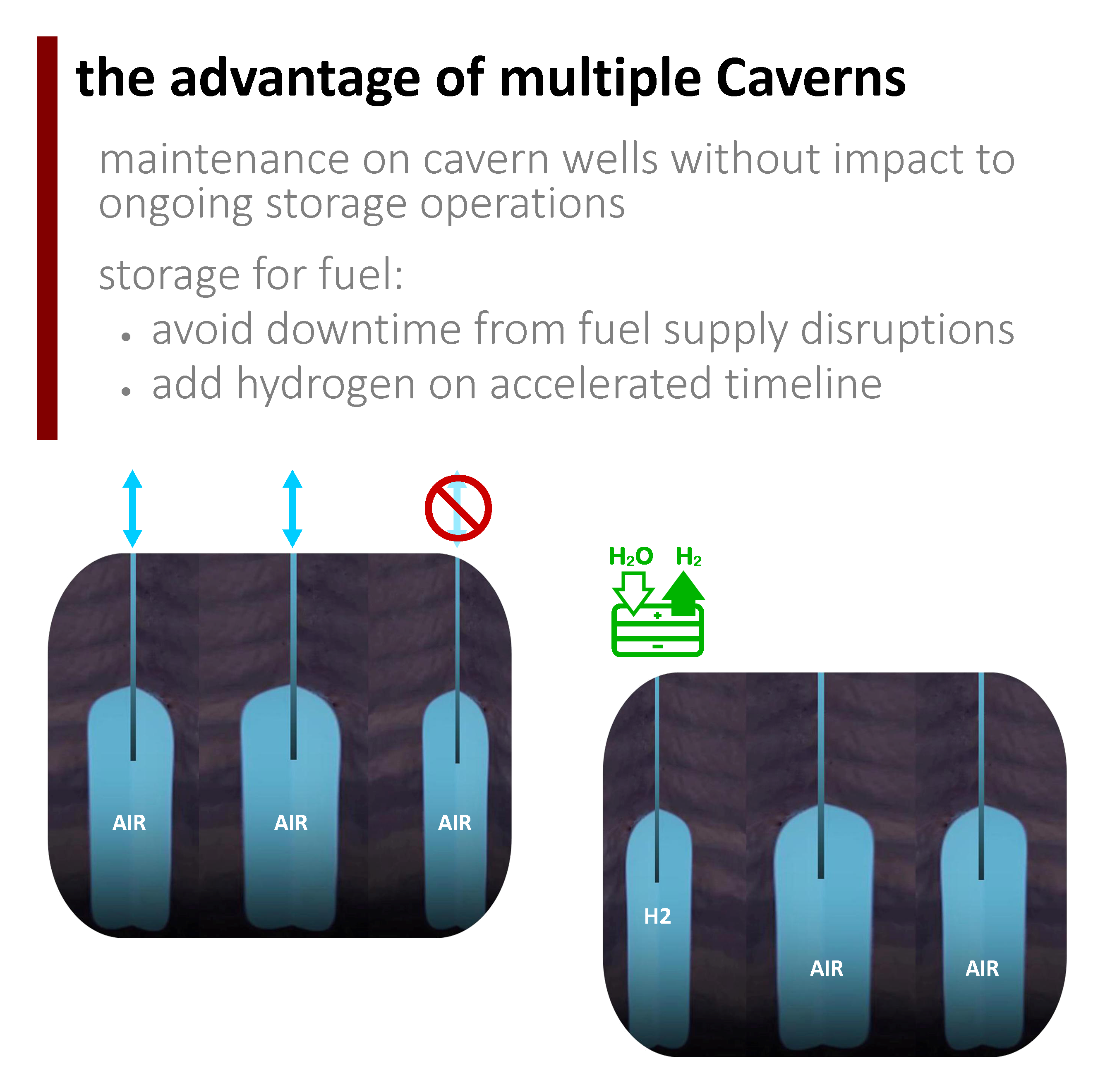
Maintenance
Multiple caverns allow the ability to maintain cavern wells without impacting ongoing operations. In a multi-cavern setup, if maintenance or repair work is required on one cavern well, the other caverns can continue to operate and provide energy storage services. This redundancy ensures that the CAES facility can maintain continuous operations and grid support even during maintenance activities.
Fuel Storage
Multiple caverns at a CAES facility provide the ability to store fuel on-site, whether it be natural gas or hydrogen. A cavern can be dedicated to storing fuel, which contributes to the overall resilience and operational flexibility of the CAES plant. This capability is particularly valuable when transitioning from natural gas to hydrogen as a fuel source, since a cavern is the most cost-effective storage alternative and allows for greater volumes of hydrogen. Additionally, having on-site fuel storage reduces the dependence on external supply chains and ensures a reliable and secure fuel source for the CAES plant, enhancing its overall operational autonomy.

